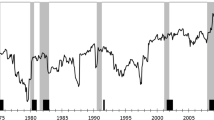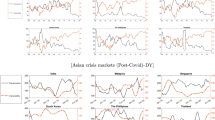Conclusions
The October 1987 stock market crash spawned an abundance of research papers, as scholars attempted to explain what seemed at the time, and to some extent remains, an inexplicable event.
Except for the period immediately around the crash, there is only meager evidence that international linkages across markets have become tighter over time. Yet the crash was worldwide in scope, and its similarity across countries was uncanny. Just on the face, this international similarity puts doubt to such explanations as particular macroeconomic events in one country, failure of a given country's market system, or simultaneous changes in underlying fundamentals (which were quite different across countries).
Assigning the origination of the crash to one country cannot be entirely ruled out, however, because of the possibility of a non-fully revealing equilibrium “contagion” process of the type suggested by King and Wadhwani (1988). Such a process would allow a world-wide crash to begin by a particular news event or even by a market “mistake” in one country. Evidence in favor of this process is that international correlations of returns increased dramatically during the crash period. However, this increase is consistent with other explanations, such as transaction costs hindering international arbitrage except during periods of high volatility.
Was the crash the bursting of a bubble? Some evidence seems to support this proposition: for example, in the majority of countries, the pre-crash period displayed significant serial dependence in stock returns, dependence that was definitely not present in the post-crash period. However, further work is necessary to ascertain whether this measured serial dependence is unusual relative to what one would have expected to find, even in a perfectly random process, by choosing a sample period that happened to culminate in a random peak. Ross (1987) shows that such ex post sample period selection will induce upward bias in estimates of serial dependence. Cross-country tests failed to detect this bias, but there are several ambiguities in the tests that will have to be resolved in future work.
The crash is history. What implications, if any, does it have for regulatory policy? Is there evidence that popular regulations or rules would have mitigated the crash, or that they would decrease price volatility in general? There is very little evidence in favor of the efficacity of margin requirements, price limits, or transactions taxes. Despite a large number of empirical studies, no one has provided evidence that margin requirements have an impact on volatility. There has been at least one recent paper claiming the contrary, but a careful examination of its methods have uncovered enough problems to cast those results into doubt.
As for price limits, there must be a very short-term impact on measured volatility, for the measured market price at a trading halt is likely to understate the direction of movement. Yet even for daily data, the cross-country evidence is slim that price limits reduce volatility, and there is no evidence at all that they work over periods as long as a week. In other words, trading halts caused by limits seem to have no effect on true volatility.
Transaction taxes are inversely but insignificantly correlated with volatility across countries, and the effect is too questionable for taxes to be used with confidence as an effective policy instrument.
Similar content being viewed by others
References
AderholdRobert, CummingChristine and HarwoodAlison. “International Linkages among Equities Markets and the October 1987 Market Break.” Federal Reserve Bank of New York Quarterly Review 13 (2, Summer 1988), 34–46.
Allen, Franklin and Gorton, Gary. “Rational Finite Bubbles.” The Wharton School, University of Pennsylvania, No. 41-88, November 1988.
Amihud, Yakov, Mendelson, Haim and Wood, Robert A. “Liquidity and the 1987 Stock Market Crash,” Graduate School of Business, New York University, April 1989.
Becker, Brandon and Underhill, David L. “Market Reform Proposals and Actions,” IIT/Chicago-Kent College of Law, Eleventh Annual Commodities Law Institute, October 1988, pp. 20–21.
BennettPaul and KelleherJeanette. “The International Transmission of Stock Price Disruption in October 1987.” Federal Reserve Bank of New York Quarterly Review 13 (2, Summer 1988), 17–33.
Bertero, Elisabetta and Mayer, Colin. “Structure and Performance: Global Interdependence of Stock Markets around the Crash of October 1987.” London: Centre for Economic Policy Research Discussion Paper No. 307, March 1989.
BrennanMichael J. “A Theory of Price Limits in Futures Markets.” Journal of Financial Economics 16 (2 June 1986), 213–233.
Camerer, Colin. “Bubbles and Fads in Asset Prices: A Review of Theory and Evidence.” Journal of Economic Surveys 3 (1, 1989 forthcoming).
DwyerGerald P.Jr. and HaferR.W. “Are National Stock Markets Linked?” Federal Reserve Bank of St. Louis Review 70 (6, November/December 1988), 3–14.
EckardtWalter L.Jr. and RogoffDonald L. “100% Margins Revisited.” Journal of Finance 31 (3, June 1976), 995–1000.
Edwards, Franklin R. “Does Futures Trading Increase Stock Market Volatility?” Financial Analysts Journal (January–February 1988a), 63–69.
Edwards, Franklin R. “Policies to Curb Stock Market Volatility.” Columbia Business School, Center for the Study of Futures Markets, Working Paper CSFM #176, August 1988b.
EstrellaArturo. “Consistent Margin Requirements: Are They Feasible?” Federal Reserve Bank of New York Quarterly Review 13 (2, Summer 1988), 61–79.
FamaEugene F. “Perspectives on October 1987 or What Did We Learn from the Crash.” In: R.W.Kamphuis, R.C.Kormendi, and J.W.H.Watson, eds., Black Monday and the Future of Financial Markets. Homewood, IL: Irwin, 1989.
Federal Reserve System, Staff of the Board of Governors. “A Review and Evaluation of Federal Margin Regulation.” Washington, D.C.: Federal Reserve, December 1984.
GarbadeKenneth D. “Federal Reserve, Margin Requirements: A Regulatory Initiative to Inhibit Speculative Bubbles.” In: P.Wachtel, ed., Crises in The Economic and Financial Structure, Lexington, MA: D.C. Health, 1982, ch. 12.
Goodhart, Charles. “The International Transmission of Asset Price Volatility.” London School of Economics Financial Markets Group, 1988.
GrossmanSanford J. “Insurance Seen and Unseen: The Impact on Markets.” Journal of Portfolio Management 14 (4, Summer 1988), 5–8.
GrubeR. Corwin, JoyO. Maurice and PantonDon B. Market Responses to Federal Reserve Changes in the Initial Margin Requirement, Journal of Finance 34 (3, June 1979), 659–673.
HamaoYasushi, MasulisRonald W. and NgVictor. “Correlation in Price Changes and Volatility Across International Stock Markets.” University of California, San Diego, February 1989.
HamiltonJames D. and WhitemanCharles H. “The Observable Implications of Self-Fulfilling Expectations.” Journal of Monetary Economics 16 (3, November 1985), 353–373.
HardouvelisGikas A. “Evidence on Stock Market Speculative Bubbles: Japan, the United States, and Great Britain.” Federal Reserve Bank of New York Quarterly Review 13 (2, Summer 1988a), 4–16.
“Margin Requirements and Stock Market Volatility.” Federal Reserve Bank of New York Quarterly Review 13 (2, Summer 1988b), 80–88.
Hardouvelis, Gikas A.. “Margin Requirements, Volatility, and the Transitory Component of Stock Prices.” First Boston Working Paper Series FB-88-38, Columbia University, Barnard Collage, November, 1988c.
Hardouvelis, Gikas A. “Stock Market Bubbles Before the Crash of 1987.” First Boston Working Paper Series #FB 89-07, Columbia University Graduate School of Business, 1989.
Harris, Lawrence. “S&P Cash Stock Price Volatilities.” School of Business Administration, University of Southern California, February, 1989.
HartzmarkMichael L. “The Effects of Changing Margin Levels on Futures Market Activity, the Composition of Traders in the Market, and Price Performance.” Journal of Business 59 (2, part 2, April 1986), S147-S180.
HilliardJimmy E. “The Relationship Between Equity Indices on World Exchanges.” Journal of Finance 34 (1, March 1979), 103–114.
HopewellMichael H. and SchwartzArthur L.Jr. “Temporary Trading Suspensions in Individual NYSE Securities.” Journal of Finance 33 (5, December 1978), 1355–1373.
Hsieh, David A. and Miller, Merton H. “Margin Regulations and Stock Market Volatility.” Graduate School of Business, University of Chicago, April, 1989.
JohnsonNormal L. and KotzSamuel. Continuous Univariate Distributions-2. New York: Wiley, 1970.
KamphuisRobert W.Jr., KormendiRoger C. and WatsonJ.W. Henry, eds., Black Monday and the Future of Financial Markets. Homewood, IL: Irwin, 1989.
King, Mervyn and Wadhwani, Sushil. “Transmission of Volatility Between Stock Markets.” London School of Economics Financial Markets Group, November 1988.
KryzanowskiLawrence. “The Efficacy of Trading Suspensions: A Regulatory Action Designed to Prevent the Exploitation of Monopoly Information.” Journal of Finance 34 (5, December 1979), 1187–1200.
LargayJames A.III. “100% Margins: Combatting Speculation in Individual Security Issues.” Journal of Finance 28 (4, September 1973), 973–986.
LargayJames A.III and WestRichard R. “Margin Changes and Stock Price Behavior.” Journal of Political Economy 81 (2, part 1, March/April 1973), 328–339.
LuckettDudley G. “On the Effectiveness of the Federal Reserve's Margin Requirement.” Journal of Finance 37 (3, June 1982), 783–795.
Ma, Christopher K., Rao, Ramesh P. and Sears, R. Stephen. “Volatility, Price Resolution and the Effectiveness of Price Limits.” Columbia Futures Center, Conference on Regulatory and Structural Reform of Stock and Futures Markets, May 1989.
Miller, Merton H. “The Crash of 1987: Bubble or Fundamental?” Keynote Address, First Annual Pacific-Basin Finance Conference, Taipei, March 1989.
MitchellMark L. and NetterJeffrey M. “Triggering the 1987 Stock Market Crash: Antitakeover Provisions in the Proposed House Ways and Means Tax Bill?” Washington, D.C.: U.S. Securities and Exchange Commission, January 1989.
NeumarkDavid, TinsleyP.A. and TosiniSusan. “After-Hours Stock Prices and Post-Crash Hangovers.” Washington, D.C.: Federal Reserve Board, Division of Research and Statistics, Finance and Economics Discussion Series 50, November 1988.
OfficerRobert R. “The Variability of the Market Factor of the New York Stock Exchange.” Journal of Business 46 (3, July 1973), 434–453.
Parhizgari, A. M., Dandapani, K. and Bhattacharya, A. K. “Global Market Place and Causality.” Finance Department, Florida International University, 1988.
Rohatyn, Felix. “A Financial House of Cards.” Time, (October 17, 1988), 48–50.
RollRichard. “Orange Juice and Weather.” American Economic Review 74 (5, December 1984), 861–880.
. “The International Crash of October, 1987.” In: K.W.Kamphuis, R.C.Kormendi, and J.W.H.Watson, eds., Black Monday and the Future of Financial Markets. Homewood, IL: Irwin, 1989, also printed in The Financial Analysts Journal, (September/October, 1988).
RossStephen A. “Uncertainty and the Heterogeneous Capital Good Model.” Review of Economic Studies 42 (1, January 1975), 133–146.
Ross, Stephen A. “Regression to the Max.” Yale School of Organization and Management, December 1987. Salinger, Michael A. “Stock Market Margin Requirements and Volatility: Implications for Regulation of Stock Index Futures.” Graduate School of Business, Columbia University, April 1989.
SamuelsonPaul A. “Indeterminancy of Development in a Heterogenous-Capital Model with Constant Saving Propensity.” In: KarlShell, ed., Essays on the Theory of Optimal Economic Growth. Cambridge, MA: MIT Press, 1967.
SantoniG. J. “The Great Bull Markets 1924–29 and 1982–87: Speculative Bubbles or Economic Fundamentals?” Federal Reserve Bank of St. Louis Review 69 (9, November 1987), 16–29.
Schwert, G. William. “Business Cycles, Financial Crises and Stock Volatility.” Working Paper BC 88-06, Bradley Policy Research Center, University of Rochester, October 1988.
Siegal, Jeremy J. “The Stock Market Crash of 1987: A Macro-Finance Perspective.” The Wharton School, University of Pennsylvania, July 1988.
SofianiosGeorge. “Margin Requirements on Equity Instruments.” Federal Reserve Bank of New York Quarterly Review 13 (2, Summer 1988), 47–60.
Stiglitz, J.E. “Using Tax Policy to Curb Speculative Short-Term Trading.” Conference on Regulatory Reform of Stock and Futures Markets, Columbia University Futures Center, May 1989.
Summers, Lawrence H. and Summers, Victoria P. “When Financial Markets Work Too Well: A Cautious Case for a Securities Transactions Tax.” Mimeo, undated.
TelserLester G. “October 1987 and the structure of Financial Markets: An Exorcism of Demons.” In: R.W.Kamphuis, R.C.Kormendi, and J.W.H.Watson, eds., Black Monday and the Future of Financial Markets. Homewood, IL: Irwin, 1989.
TiroleJean. “On the Possibility of Speculation Under Rational Expectations.” Econometrica 50 (5, September 1982), 1163–1181.
. “Asset Bubbles and Overlapping Generations.” Econometrica 53 (5, September 1985), 1071–1100.
WachtelPaul. Crises in the Economic and financial Structure. Lexington, MA: D.C. Health, 1982.
Author information
Authors and Affiliations
Rights and permissions
About this article
Cite this article
Roll, R. Price volatility, international market links, and their implications for regulatory policies. J Finan Serv Res 3, 211–246 (1989). https://doi.org/10.1007/BF00122803
Issue Date:
DOI: https://doi.org/10.1007/BF00122803




